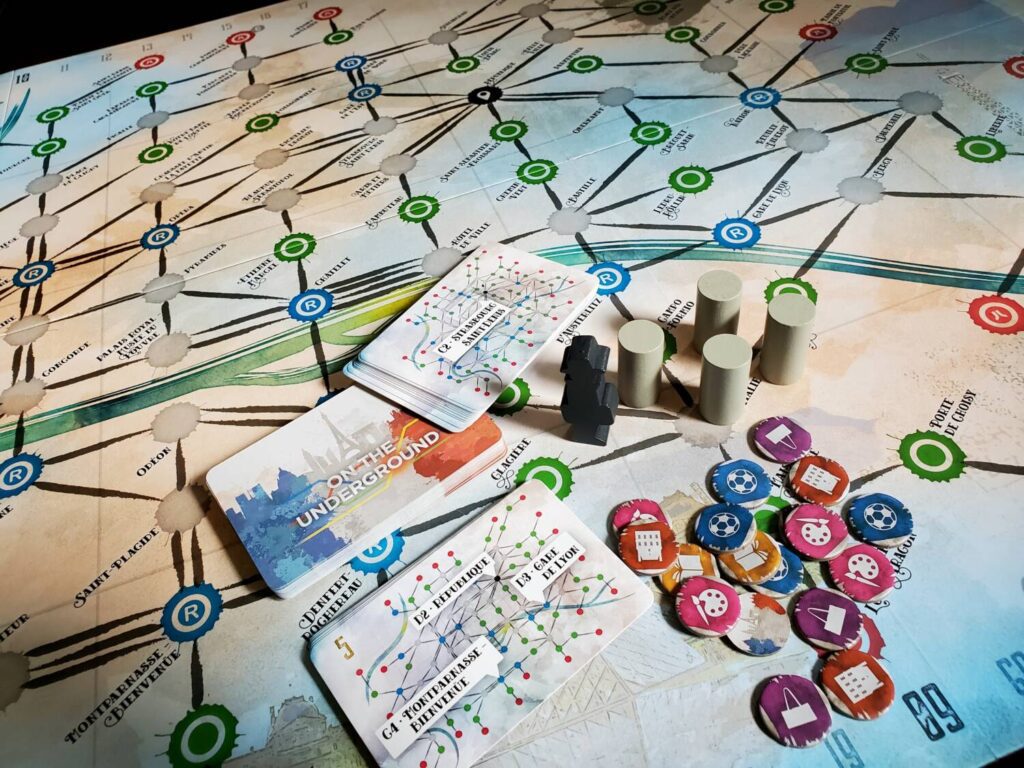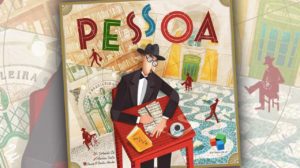Disclosure: Meeple Mountain received a free copy of this product in exchange for an honest, unbiased review. This review is not intended to be an endorsement.
I am relatively certain that I have never uttered the following phrase, but I absolutely adore the box bottoms of both On the Underground titles. Inside the shrink, LudiCreations included a paper print of the standard fare: barcode, description, picture of the board, etc. But my heart smiled—twice—when the glossy stock fell away, revealing a partner image to the box top. The London top is paired with a Berlin bottom. Likewise, the Paris lid features a New York bottom. The silhouetted watercolor style is the same, creating six-sided beauty.
My second realization upon opening the two boxes—for they arrived together—was that each box contained roughly 60% wasted space. This, perhaps unexpectedly, also made me smile because I realized that a fan of the games could combine the two titles in one box (with mixed and matched box parts) with room to spare. One man’s waste is another man’s opportunity, I suppose.

As for the physical contents, London / Berlin and Paris / New York are approximately identical: a behemoth, two-sided, six-fold map board, baggies of sticks representing tracks, a handful of cardboard tokens, a few site markers, and, of course, the Traveler. The one notable difference is the absence of the yellow site markers. The rest of the differences play out on the maps.
If you are not familiar with the gameplay, check out my review of On the Underground: London / Berlin for a functional summary.
New York
Like its London counterpart, New York is an entry offering of On the Underground. The map focuses (exercising artistic license) on Manhattan and Brooklyn, with the East River in between. Without yellow sites, the Traveler simply visits two sites on every turn of the game in order of ease. One map-related objective involves crossing the river multiple times with track lines—three complete bridges earn a bonus. The other involves creating connections among five high-traffic areas. The remainder of the spots are familiar single-point stops and terminus points.

Paris
The Paris map draws the most alarming sounds from any who have played the game before, primarily for the sheer number of single lines on the board. The rules here add a function to the Branch tokens, allowing a pair to purchase the right to add a line where no track is prescribed. This little adjustment creates an economy unlike any of the other iterations.
In addition, a collection of 40 Landmark tiles are scattered about for collection into sets of five. Unlike Berlin, there is no strategic advantage to hoarding a particular type in hopes of denying others the joy of a set. Here the tokens are an all-or-nothing set-collecting proposition. Adding one more wrinkle, the deck of destinations is smaller and the Traveler only moves once with each turn. The movement is more subdued, leaving room and time to plan for those dastardly single lines.

I’m glad the design team left private objectives out until this fourth map. I celebrate the effort to distinguish On the Underground from the moves one might expect from a route-layer. But here in Paris, players receive cards with three locations on the map and a commission to connect them with a single line (a la Get on Board). The delightful twist is that the objectives might potentially be accomplished by multiple lines. In a two-player outing, where players each manage four different-colored lines, the fun and strategic opportunities multiply with these cards.
Does anyone need both?
Need is such a strong word. If you enjoy the differences in the first On the Underground, you are likely to enjoy the range of differences across both boxes. Dropping the forced movement of the yellow destination marker casts a large shadow over this second design. Somehow, the fact that the Traveler’s movement was in some way determined by somewhat irrationally distant need made a positive difference in the game. In this second box, the gray-only approach means the Traveler is always, only, ever lazy, never needing to be anywhere, only choosing to go where feet may rest. Still, the loss of the brighter cylinder opens the door to fascinating challenges.
I definitely prefer the new scoring activity here in the Paris / New York box. Crossing the East River is entertaining, as is the labor to connect four, or even five (is that possible?) of the high-traffic areas. Likewise, Paris’s single-lane grid is a lovely sort of tension, especially in the late-game effort to manufacture costly points. Where the Branches take on added significance in these rulesets, the Landmark-style token activity is roughly the same, so I can’t say it swings the vote.
To date, I’ve most often used London to learn and teach the system, especially with the family. Berlin was a great and natural change of pace. I think I’ve found the second box to be a bit more robust and satisfying in my successes, though. Especially on the French side.
Ultimately, these two redesigned game boxes in the series are remarkably similar, which makes me say anyone would be happy with one; yet each holds its identity well enough to be a distinct experience. The balance of the design is ever-present, and the interaction only intensifies by the time you reach Paris. For my tastes, I would purchase Paris / New York if I had to choose, but it’s more for the sake of my preferences than any particular perceived flaw. For the moment, I have them in one glorious box among the collection so we have options when it hits the table.
Both games are wonderfully designed in their own way. Much like its predecessor, I give On the Underground: Paris / New York a hearty recommendation. Like the Traveler, I’m just waiting to see where the rails look to carry me next.












Add Comment